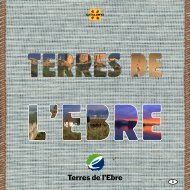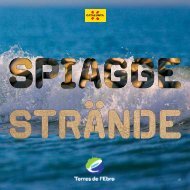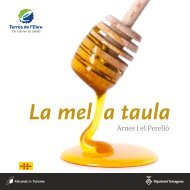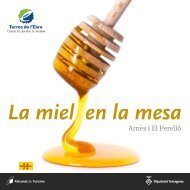Descarrega la llista patró dels ocells del delta de l ... - Terres de l'Ebre
Descarrega la llista patró dels ocells del delta de l ... - Terres de l'Ebre
Descarrega la llista patró dels ocells del delta de l ... - Terres de l'Ebre
You also want an ePaper? Increase the reach of your titles
YUMPU automatically turns print PDFs into web optimized ePapers that Google loves.
Abreviacions <strong>de</strong> <strong>la</strong> columna<br />
d’abundància<br />
Grau d’abundància:<br />
Ab: abundant (Abundant)<br />
C: comú (Common)<br />
U: poc comú (Uncommon)<br />
S: escàs (Scarce)<br />
R: rar (Rare)<br />
Ac: acci<strong>de</strong>ntal (Acci<strong>de</strong>ntal)<br />
Exemples:<br />
Pha<strong>la</strong>crocorax carbo sinensis: Ab, W & P / S, NbS / Ac, BR<br />
Abundant com a hivernant i migrant / Escàs com a estival no<br />
reproductor / Acci<strong>de</strong>ntal com a reproductor resi<strong>de</strong>nt<br />
Motacil<strong>la</strong> f<strong>la</strong>va iberiae: Ab, P / U, BS / R, W<br />
Abundant com a migrant / Poc comú com a reproductor estival /<br />
Rar com a hivernant<br />
Motacil<strong>la</strong> f<strong>la</strong>va cinereocapil<strong>la</strong>: S, P / R, BS<br />
Escàs com a migrant / Rar com a reproductor estival<br />
El sistema <strong>de</strong> c<strong>la</strong>ssificació <strong><strong><strong>de</strong>l</strong>s</strong> <strong>ocells</strong> presents en un territori<br />
segons les categories ABCD i E és àmpliament emprat<br />
en l’e<strong>la</strong>boració <strong>de</strong> les llistes <strong>patró</strong> en un gran nombre <strong>de</strong><br />
contra<strong>de</strong>s europees (AERC TAC 2003, C<strong>la</strong>vell et al. 2006,<br />
GAE-SEO 2006, Gorospe 2007, etc.). L’objectiu d’aquest<br />
sistema és, en una primera aproximació, distingir els tàxons<br />
autòctons i al·lòctons naturalitzats (categories A, B i C)<br />
d’aquells al·lòctons o reintroduïts no plenament establerts<br />
(D i E). So<strong>la</strong>ment el primer grup conforma en sentit estricte<br />
el catàleg <strong>de</strong> <strong>la</strong> Llista Patró, <strong>la</strong> qual està integrada per:<br />
espècies que han estat observa<strong>de</strong>s en estat natural <strong>de</strong>s <strong>de</strong><br />
1950 (categoria A), espècies actualment no presents però<br />
que han estat cita<strong>de</strong>s en estat natural entre 1800 i 1950<br />
(B), i espècies introduï<strong>de</strong>s o reintroduï<strong>de</strong>s que han establert<br />
pob<strong>la</strong>cions reproductores autònomament sostenibles (C).<br />
El segon grup <strong>de</strong> categories (D i E) es refereix a espècies<br />
al·lòctones o proce<strong>de</strong>nts <strong>de</strong> reintroduccions el manteniment<br />
<strong>de</strong> les quals <strong>de</strong>pèn encara <strong>de</strong> <strong>la</strong> mà <strong>de</strong> l’home, tot i que<br />
<strong>de</strong> manera ocasional o irregu<strong>la</strong>r s’hagi pogut comprovar <strong>la</strong><br />
seva reproducció en estat salvatge. Amb el temps, aquests<br />
tàxons po<strong>de</strong>n es<strong>de</strong>venir espècies pròpies <strong>de</strong> <strong>la</strong> Llista Patró,<br />
sempre que s’hi estableixin autònomament.<br />
Definicions <strong>de</strong> les categories A, B, C, D i E<br />
Categoria A Espècies que han estat cita<strong>de</strong>s en estat aparentment natural<br />
almenys un cop <strong>de</strong>s <strong>de</strong> l’1 <strong>de</strong> gener <strong>de</strong> 1950<br />
Categoria B Espècies que havien estat cita<strong>de</strong>s en estat aparentment natural<br />
almenys un cop <strong>de</strong>s <strong>de</strong> 1800 fins al 31 <strong>de</strong> <strong>de</strong>sembre <strong>de</strong><br />
1949, però que no han estat cita<strong>de</strong>s posteriorment<br />
Categoria C Espècies que, malgrat haver estat introduï<strong>de</strong>s o reintroduï<strong>de</strong>s<br />
per l’home, <strong>de</strong> manera <strong><strong>de</strong>l</strong>iberada o acci<strong>de</strong>ntal, han establert<br />
pob<strong>la</strong>cions reproductores que es mantenen autònomament<br />
sense necessitat <strong>de</strong> noves introduccions o reintroduccions<br />
Subcategoria C1 Espècies exòtiques. Espècies que han estat cita<strong>de</strong>s només<br />
com a resultat d’una introducció<br />
Subcategoria C2 Espècies natives introduï<strong>de</strong>s. Espècies amb pob<strong>la</strong>cions establertes<br />
com a resultat <strong>de</strong> <strong>la</strong> introducció per l’home, però que<br />
també es citen en estat aparentment natural<br />
Subcategoria C3 Espècies reintroduï<strong>de</strong>s. Espècies amb pob<strong>la</strong>cions reintroduï<strong>de</strong>s<br />
amb èxit per l’home en àrees on es trobaven anteriorment.<br />
Subcategoria C4 Espècies assilvestra<strong>de</strong>s. Espècies domèstiques (és a dir,<br />
selecciona<strong>de</strong>s artificialment) amb pob<strong>la</strong>cions establertes en<br />
llibertat<br />
Subcategoria C5 Espècies naturalitza<strong>de</strong>s en àrees veïnes. Espècies amb pob<strong>la</strong>cions<br />
naturalitza<strong>de</strong>s en altres països <strong>de</strong> <strong>la</strong> mateixa regió<br />
Categoria D Espècies que haurien d’aparèixer amb categoria A o B, però<br />
hi ha dubtes raonables que mai s’hagin observat en estat natural.<br />
No formen part <strong><strong>de</strong>l</strong> total d’espècies i no es contemplen<br />
com a integrants <strong>de</strong> <strong>la</strong> <strong>llista</strong><br />
Categoria E Espècies que han estat cita<strong>de</strong>s com a introduccions o<br />
reintroduccions, transporta<strong>de</strong>s o escapa<strong>de</strong>s <strong>de</strong> captivitat, les<br />
pob<strong>la</strong>cions reproductores <strong>de</strong> les quals (si n’hi ha) es creu que<br />
no es mantenen per elles mateixes. No formen part <strong><strong>de</strong>l</strong> total<br />
d’espècies i no es contemplen com a integrants <strong>de</strong> <strong>la</strong> <strong>llista</strong><br />
Subcategoria E1 Espècies <strong>de</strong> les que s’ha comprovat <strong>la</strong> reproducció <strong>de</strong> forma<br />
regu<strong>la</strong>r, i <strong>de</strong> les que existeixen sospites que po<strong>de</strong>n estar<br />
establint-se. Les espècies en aquesta subcategoria han <strong>de</strong><br />
ser objecte d’un especial seguiment per a consi<strong>de</strong>rar <strong>la</strong> seva<br />
inclusió en <strong>la</strong> categoria C.<br />
Subcategoria E2 Espècies <strong>de</strong> les que s’ha comprovat <strong>la</strong> reproducció en llibertat<br />
<strong>de</strong> forma irregu<strong>la</strong>r o ocasional, sense cap indici que es trobin<br />
en procés d’establiment<br />
Subcategoria E3 Espècies observa<strong>de</strong>s només <strong>de</strong> forma ocasional, sense haverne<br />
constatat <strong>la</strong> seva reproducció








